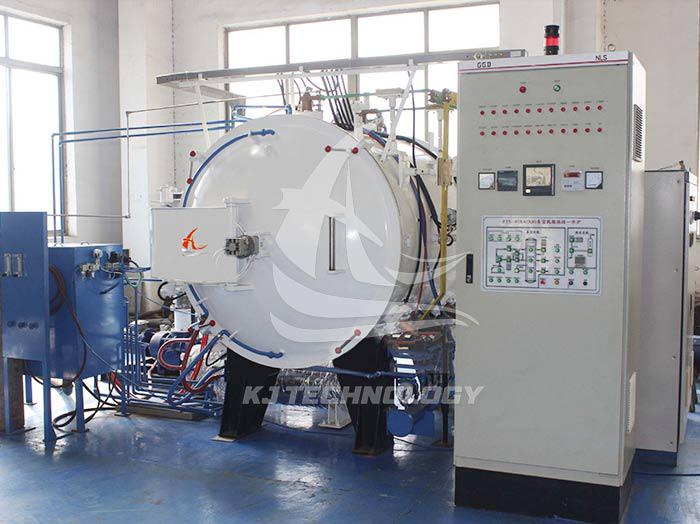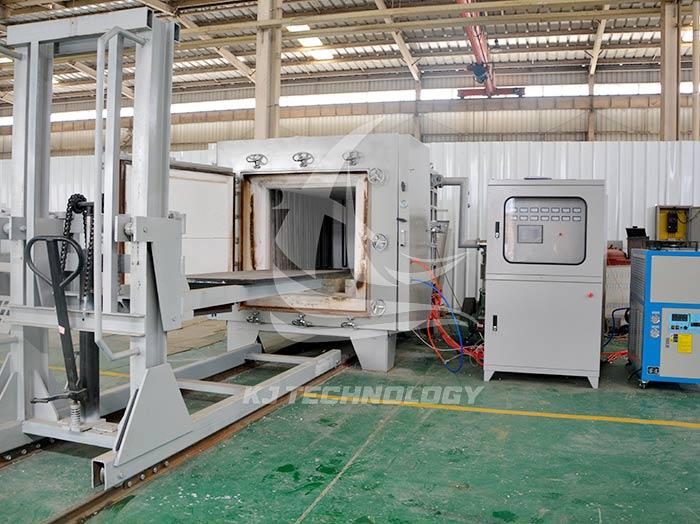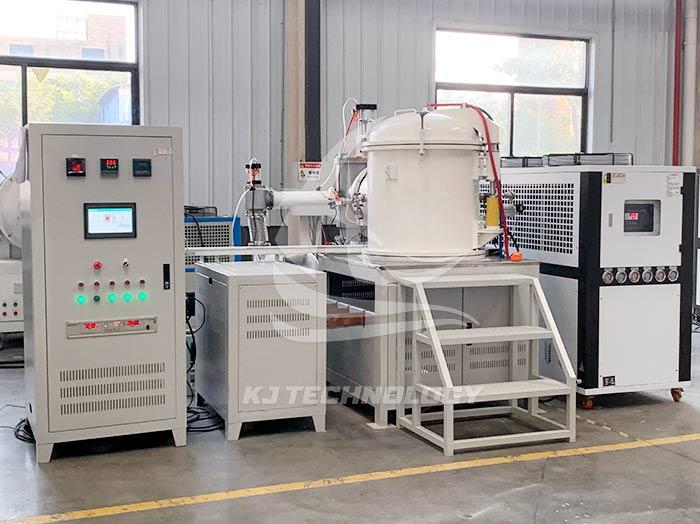What are the specific effects of vacuum environment on material processing?
 07-14-2025 Author: KJ technology
07-14-2025 Author: KJ technology
The vacuum environment has multiple specific impacts on material processing by reducing gas pressure and eliminating oxidizing substances, covering core dimensions such as physical properties, chemical stability, surface quality, and process feasibility. The following is a specific analysis:
1. Physical performance optimization: suppress defects, enhance mechanical and thermal properties
Reduce porosity and looseness
Principle: In a vacuum environment, the partial pressure of gases inside the material (such as adsorbed gases and residual gases in pores) decreases, promoting gas escape and reducing pore formation during sintering or solidification processes.
Case: During vacuum sintering, the porosity of hard alloy (WC Co) can be reduced to below 0.1%, significantly lower than that of hydrogen protected sintering (porosity of about 0.5%), thereby improving hardness and bending strength.
Improve grain growth and tissue uniformity
Principle: The vacuum environment reduces the obstruction of gas on grain boundary migration, promotes uniform grain growth, and avoids uneven performance caused by local abnormal growth.
Case: After vacuum annealing, the standard deviation of grain size of high-temperature alloys (such as Inconel 718) decreases by 30%, and the high-temperature endurance strength increases by 15%.
Enhance thermal conductivity and electrical conductivity
Principle: Vacuum treatment can remove surface oxide films or internal impurities of materials, reduce phonon/electron scattering, and improve thermal/electrical transmission efficiency.
Case: After vacuum annealing, the conductivity of high-purity copper reaches 103% IACS (International Annealed Copper Standard), approaching the theoretical limit.
2. Improved chemical stability: prevents oxidation and decarbonization, retains original components
Inhibit high-temperature oxidation
Principle: The oxygen partial pressure in a vacuum environment is extremely low (usually<10 ⁻ ³ Pa), far below the equilibrium partial pressure of metal oxidation reaction, thereby blocking the oxidation reaction.
Case: After vacuum heat treatment, the surface oxide layer thickness of titanium alloy (Ti-6Al-4V) decreased from the conventional treatment of 2 μ m to below 0.1 μ m, and the fatigue life was increased by 40%.
Avoid decarbonization and carbonization
Principle: The vacuum environment eliminates CO ₂ and O ₂ from the air, preventing the surface carbon of the steel from being oxidized (decarburization) or reacting with a carbon containing atmosphere (carbonization).
Case: After vacuum quenching, the fluctuation range of surface carbon content of high-speed steel (M2) is reduced from ± 0.05% to ± 0.02%, and the hardness uniformity is improved by 2 HRC units.
Reduce the risk of hydrogen embrittlement
Principle: Vacuum treatment can reduce the solubility of hydrogen in materials, promote the diffusion of hydrogen atoms to the surface and escape, and avoid brittle fracture caused by hydrogen aggregation.
Case: After vacuum dehydrogenation treatment, the hydrogen content of high-strength steel (such as 42CrMo4) decreased from 8ppm to below 2ppm, and the fracture toughness increased by 50%.
3. Surface quality improvement: smoothness enhancement and impurity control
Realize surface gloss purification
Principle: The vacuum environment removes impurities such as oil and phosphorus particles adsorbed on the surface, while suppressing the formation of oxide films, resulting in a metallic luster on the material surface.
Case: After vacuum annealing, the surface roughness Ra of stainless steel tableware decreased from 0.8 μ m to 0.2 μ m, achieving a mirror effect without the need for subsequent polishing.
Reduce surface pollution and inclusions
Principle: The vacuum system achieves high vacuum degree (up to 10 ⁻⁵ Pa) through molecular pumps or diffusion pumps, significantly reducing the content of pollutants such as dust and metal particles in the atmosphere.
Case: After vacuum heat treatment, the surface particle contamination density of semiconductor silicon wafers decreased from 10 ³/cm ² to 10 ²/cm ², meeting the requirements of integrated circuit manufacturing.
Control the thickness of the surface reaction layer
Principle: In a vacuum atmosphere composite environment, the degree of reaction between the material surface and the gas can be controlled by precisely regulating the gas partial pressure.
Case: Aluminum alloy undergoes micro arc oxidation in a vacuum nitrogen environment, and the thickness of the surface aluminum oxide ceramic layer is precisely controlled from the conventional treatment of 20 μ m to 10 μ m, improving wear resistance while retaining toughness.
4. Process feasibility extension: supports special materials and extreme conditions processing
Realize safe handling of active metals
Principle: A vacuum environment avoids the reaction of active metals (such as beryllium and thorium) with oxygen and water vapor, preventing the risk of combustion or explosion.
Case: During vacuum melting and heat treatment of beryllium copper alloy (C17200), the oxygen content can be controlled below 50ppm to avoid the formation of brittle phases.
Promote densification of refractory metals
Principle: Vacuum sintering can lower the sintering temperature of refractory metals such as tungsten and molybdenum, while reducing volatilization losses and increasing density.
Case: After vacuum hydrogen sintering, the density of pure tungsten increased from 18.5g/cm ³ to 19.3g/cm ³ (theoretical density), approaching complete density.
Support the synthesis of high-temperature superconducting materials
Principle: The vacuum environment prevents superconducting materials (such as YBCO) from reacting with oxygen and carbon dioxide at high temperatures, while precisely controlling the oxygen partial pressure to optimize the crystal structure.
Case: After annealing in a vacuum oxygen composite atmosphere, the critical current density of YBCO superconductors increased from 1MA/cm ² to 3MA/cm ², approaching the practical level.
5. The key influence of vacuum degree on processing effect
Vacuum degree (i.e. gas pressure) is the core parameter that determines the processing effect, and different vacuum degree ranges correspond to different application scenarios:
10 ⁵~10 ³: Low vacuum annealing, drying, preliminary removal of surface moisture, reducing oxidation risk, but unable to completely suppress decarburization.
10 ³~10 ⁻¹: Medium vacuum sintering and brazing significantly reduce porosity and improve density, suitable for materials such as ceramics and intermetallic compounds.
10 ⁻¹~10 ⁻⁴: High vacuum heat treatment and coating, completely avoiding oxidation, achieving surface bright purification, supporting the treatment of active metals and superconducting materials.
<10 ⁻⁴: Research on ultra-high vacuum materials, semiconductor processes, removal of surface adsorbed gases, control of single atomic layer reactions, meeting the preparation needs of nanomaterials and quantum devices.
6. Limitations and coping strategies of vacuum processing
High equipment cost
Problem: High vacuum pumps, seals, and other components are expensive and require complex maintenance.
Strategy: Adopt segmented vacuum design and use low vacuum in non critical process sections to reduce overall costs.
Long processing cycle
Problem: Vacuum pumping and cooling time account for a large proportion, affecting production efficiency.
Strategy: Optimize the furnace structure (such as short path exhaust system), or adopt local vacuum technology (such as vacuum induction heating).
Material volatilization risk
Problem: Low melting point elements (such as zinc and magnesium) are prone to volatilization under vacuum, leading to component segregation.
Strategy: Control the vacuum degree and temperature curve, or use filling gas (such as argon) to suppress volatilization.








